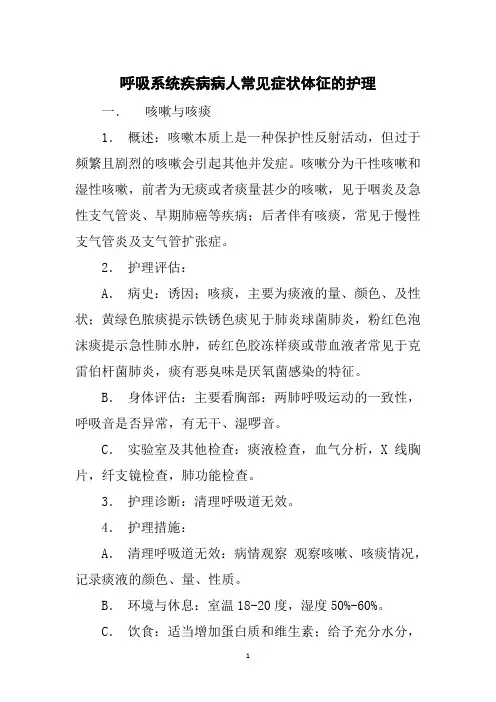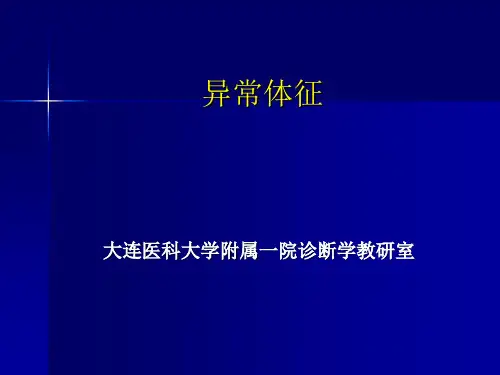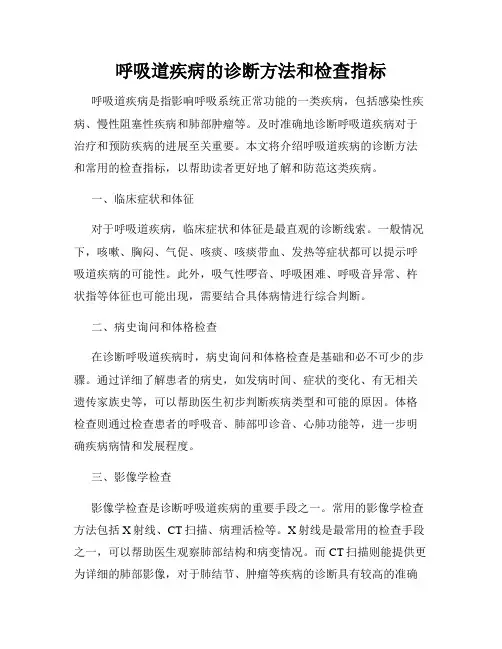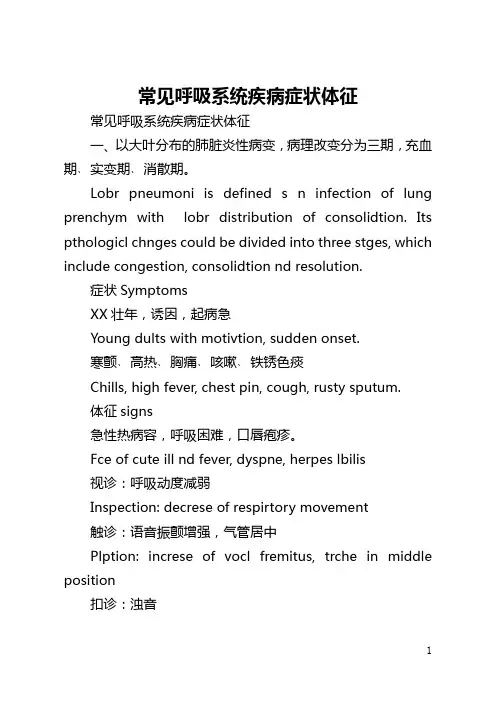常见呼吸系统疾病症状体征
- 格式:doc
- 大小:78.01 KB
- 文档页数:5


呼吸系统疾病病人常见症状体征的护理一.咳嗽与咳痰1.概述:咳嗽本质上是一种保护性反射活动,但过于频繁且剧烈的咳嗽会引起其他并发症。
咳嗽分为干性咳嗽和湿性咳嗽,前者为无痰或者痰量甚少的咳嗽,见于咽炎及急性支气管炎、早期肺癌等疾病;后者伴有咳痰,常见于慢性支气管炎及支气管扩张症。
2.护理评估:A.病史:诱因;咳痰,主要为痰液的量、颜色、及性状;黄绿色脓痰提示铁锈色痰见于肺炎球菌肺炎,粉红色泡沫痰提示急性肺水肿,砖红色胶冻样痰或带血液者常见于克雷伯杆菌肺炎,痰有恶臭味是厌氧菌感染的特征。
B.身体评估:主要看胸部:两肺呼吸运动的一致性,呼吸音是否异常,有无干、湿啰音。
C.实验室及其他检查:痰液检查,血气分析,X线胸片,纤支镜检查,肺功能检查。
3.护理诊断:清理呼吸道无效。
4.护理措施:A.清理呼吸道无效:病情观察观察咳嗽、咳痰情况,记录痰液的颜色、量、性质。
B.环境与休息:室温18-20度,湿度50%-60%。
C.饮食:适当增加蛋白质和维生素;给予充分水分,使每天饮水量达到1.5L-2L。
D.促进有效排痰:a. 有效咳嗽:适用于神志清醒的病人,方法:病人采取坐位,腹式呼吸5-6次,屏气3-5秒,继而缩唇,缓慢呼气,再深吸一口气屏气3-5秒,身体前倾,进行2-3次短促有力的咳嗽。
如胸部有伤口可用双手或枕头轻压伤口两侧,使伤口两侧的皮肤及软组织向伤口处皱起,避免牵拉疼痛。
b. 胸部叩击:适用于久病体弱,长期卧床,排痰无力者。
c.胸部叩击:适用于久病体弱,长期卧床,排痰无力者。
d.体位引流:适用于肺脓肿、支气管扩张症等有大量痰液排出不畅时。
e.机械吸痰:适用于痰液黏稠无力咳出、意识不清或建立人工气道者。
二.肺源性呼吸困难1.概述:呼吸困难是呼吸时有异常的不舒服感,病人主观上感到空气不足、呼吸费力,客观上可能有呼吸频率、节律的改变及辅助呼吸肌参与呼吸运动等体征。
肺源性呼吸困难是由于呼吸系统疾病引起通气和(或)换气功能障碍,造成机体缺氧和(或)二氧化碳潴留所致。








呼吸道疾病的诊断方法和检查指标呼吸道疾病是指影响呼吸系统正常功能的一类疾病,包括感染性疾病、慢性阻塞性疾病和肺部肿瘤等。
及时准确地诊断呼吸道疾病对于治疗和预防疾病的进展至关重要。
本文将介绍呼吸道疾病的诊断方法和常用的检查指标,以帮助读者更好地了解和防范这类疾病。
一、临床症状和体征对于呼吸道疾病,临床症状和体征是最直观的诊断线索。
一般情况下,咳嗽、胸闷、气促、咳痰、咳痰带血、发热等症状都可以提示呼吸道疾病的可能性。
此外,吸气性啰音、呼吸困难、呼吸音异常、杵状指等体征也可能出现,需要结合具体病情进行综合判断。
二、病史询问和体格检查在诊断呼吸道疾病时,病史询问和体格检查是基础和必不可少的步骤。
通过详细了解患者的病史,如发病时间、症状的变化、有无相关遗传家族史等,可以帮助医生初步判断疾病类型和可能的原因。
体格检查则通过检查患者的呼吸音、肺部叩诊音、心肺功能等,进一步明确疾病病情和发展程度。
三、影像学检查影像学检查是诊断呼吸道疾病的重要手段之一。
常用的影像学检查方法包括X射线、CT扫描、病理活检等。
X射线是最常用的检查手段之一,可以帮助医生观察肺部结构和病变情况。
而CT扫描则能提供更为详细的肺部影像,对于肺结节、肿瘤等疾病的诊断具有较高的准确性。
在某些情况下,医生还可能会通过进行病理活检来明确病变的性质与严重程度。
四、呼吸功能检查呼吸功能检查是评估呼吸道疾病严重程度和监测治疗效果的重要手段。
肺功能测试是一种简单、无创的检查方法,通过呼吸机和相关仪器测量各种呼吸参数,如肺活量、通气量、换气功能等,以评估呼吸道疾病对呼吸功能的影响。
五、生化指标检查生化指标检查可以从血液和其他体液中获取相关信息,帮助医生判断疾病类型和发展程度。
比如,白细胞计数和C-反应蛋白等常用于判断是否存在细菌感染;血气分析则可以评估氧气和二氧化碳的水平,以及血液的酸碱平衡情况。
此外,炎症标志物、肿瘤标志物等指标也有助于呼吸道疾病的诊断和评估。

常见呼吸系统疾病症状体征常见呼吸系统疾病症状体征一、以大叶分布的肺脏炎性病变,病理改变分为三期,充血期﹑实变期﹑消散期。
Lobr pneumoni is defined s n infection of lung prenchym with lobr distribution of consolidtion. Its pthologicl chnges could be divided into three stges, which include congestion, consolidtion nd resolution.症状SymptomsXX壮年,诱因,起病急Young dults with motivtion, sudden onset.寒颤﹑高热﹑胸痛﹑咳嗽﹑铁锈色痰Chills, high fever, chest pin, cough, rusty sputum.体征signs急性热病容,呼吸困难,口唇疱疹。
Fce of cute ill nd fever, dyspne, herpes lbilis视诊:呼吸动度减弱Inspection: decrese of respirtory movement触诊:语音振颤增强,气管居中Plption: increse of vocl fremitus, trche in middle position扣诊:浊音Percussion: dullness听诊:管状呼吸音,胸膜摩擦音,湿罗音usculttion: bronchil breth sound, pleurl friction rub, rles.二﹑慢性堵塞性肺病(chronic obstructive pulmonry disese COPD)慢性堵塞性肺病是一种具有气流受限特征的肺部疾病,气流受限不完全可逆,呈进行性进展。
确切的病因还不十分清楚,但认为与肺部对有害气体或有害颗粒的异常炎症反应有关。
呼吸系统常见疾病主要症状和体征呼吸系统是人体的重要组成部分,负责从外部吸入氧气并排出二氧化碳,维持机体的正常代谢。
然而,呼吸系统也容易受到各种疾病的侵害,引发一系列症状和体征。
本文将总结呼吸系统常见疾病的主要症状和体征,以便及早发现和治疗。
一、上呼吸道感染上呼吸道感染是呼吸系统最常见的疾病之一,包括感冒、流感、鼻窦炎等。
其主要症状包括:1. 发热:上呼吸道感染常伴有发热,体温可在37.5℃-39℃之间。
2. 流涕和鼻塞:常出现打喷嚏、鼻塞以及鼻腔分泌物增多等症状。
3. 喉咙痛:喉咙痛是上呼吸道感染的常见症状,患者常感到喉咙干燥、灼热或疼痛。
4. 咳嗽:干咳是上呼吸道感染病情较轻时的常见体征,以咳嗽声音尖锐为特征。
5. 肌肉酸痛:上呼吸道感染也可引起肌肉酸痛、乏力等非特异性症状。
二、哮喘哮喘是一种慢性的气道疾病,其症状主要包括:1. 呼吸困难:哮喘的典型症状是呼吸困难,特别是在夜间或早晨更为明显。
2. 喘息:患者常出现喘息音,伴有呼气困难和胸闷感。
3. 咳嗽:哮喘患者的咳嗽常常是在夜间或清晨发作,尤其在寒冷环境或暴露于诱发因素后更为明显。
4. 胸痛:胸痛是哮喘患者的常见症状之一,常表现为胸闷、紧迫感或隐痛。
5. 喘息性呼吸:患者在呼气时呼吸困难,呼气时间明显延长,出现喘息性呼吸。
三、慢性阻塞性肺疾病(COPD)COPD是一种慢性进行性的肺部疾病,主要由慢性支气管炎和肺气肿两部分组成。
其主要症状和体征包括:1. 气短:患者在日常活动中容易出现气短,特别是运动或上楼梯时更为明显。
2. 慢性咳嗽:慢性咳嗽是COPD的典型症状之一,且表现为长期持续的咳嗽。
3. 咳痰:咳嗽伴随有大量黏液的咳痰是COPD的主要特点,且常常在早晨发作。
4. 胸闷:COPD患者常感到胸闷、胸痛或不适。
5. 杵状指:COPD晚期可出现杵状指,指尖增粗、指甲扩张。
四、肺炎肺炎是肺部感染引起的疾病,常见症状和体征有:1. 发热:肺炎常伴有高热,体温可达到39℃以上。
呼吸系统疾病病人常见症状体征的护理呼吸系统疾病是指影响呼吸道和肺部功能的疾病,常见的疾病包括哮喘、肺炎、阻塞性睡眠呼吸暂停综合征等。
这些疾病会导致患者出现一系列的症状和体征,如呼吸困难、咳嗽、气促、胸痛等。
在护理患者时,我们需要密切关注患者的症状和体征变化,并采取相应的护理干预措施。
首先,对于呼吸困难患者,我们需要保持患者呼吸道通畅。
护理人员应保持患者体位舒适,保持好气道通畅。
如果患者有分泌物堵塞气道,应及时清除分泌物,可以通过吸痰、气管插管等方式,确保患者的气道通畅。
其次,对于气促患者,我们需要教育患者正确的呼吸方式。
教育患者腹式呼吸,通过深呼吸来提高肺部通气量,并减轻患者的呼吸负担。
同时,我们还可以引导患者使用辅助呼吸器具,如呼吸器或氧气机等,来帮助患者更好地呼吸。
另外,对于咳嗽患者,我们需要根据患者的咳嗽特点来选择合适的护理措施。
对于干咳患者,我们可以给予患者保湿剂或止咳药物,帮助患者减轻咳嗽症状。
对于有痰患者,我们可以通过适当的水分摄入来帮助患者稀化痰液,易于排出。
最后,对于胸痛患者,我们需要密切监测患者的疼痛程度,并针对性地给予控制疼痛的药物。
同时,我们还需要帮助患者改变体位,如坐起或侧卧,以减轻胸痛。
除了上面提到的护理措施,我们还需要密切监测患者的病情变化。
包括定期测量患者的体温、脉搏、呼吸、血压和血氧饱和度等生命体征,并记录下来。
同时,我们还需要密切关注患者的体征变化,如皮肤颜色、形态、呼吸音等。
另外,我们还需要给予患者充足的休息和营养,提供良好的护理环境,保持房间通风,控制空气湿度等。
同时,我们也需要加强对患者的心理支持,鼓励患者保持良好的心态,积极配合治疗。
综上所述,针对呼吸系统疾病患者常见症状体征的护理,我们需要保持患者的呼吸道通畅,教育患者正确的呼吸方式,控制患者的疼痛,监测患者的病情变化,提供充足的休息和营养,给予良好的心理支持。
通过以上护理措施的实施,可以帮助患者缓解症状,促进康复。
常见呼吸系统疾病症状体征一、以大叶分布的肺脏炎性病变,病理改变分为三期,充血期﹑实变期﹑消散期。
Lobar pneumonia is defined as an infection of lung parenchyma with a lobar distribution of consolidation. Its pathological changes could be divided into three stages, which include congestion, consolidation and resolution.症状Symptoms青壮年,诱因,起病急Young adults with motivation, sudden onset.寒颤﹑高热﹑胸痛﹑咳嗽﹑铁锈色痰Chills, high fever, chest pain, cough, rusty sputum.体征signs急性热病容,呼吸困难,口唇疱疹。
Face of acute ill and fever, dyspnea, herpes labialis视诊:呼吸动度减弱Inspection: decrease of respiratory movement触诊:语音振颤增强,气管居中Palpation: increase of vocal fremitus, trachea in middle position扣诊:浊音Percussion: dullness听诊:管状呼吸音,胸膜摩擦音,湿罗音Auscultation: bronchial breath sound, pleural friction rub, rales.二﹑慢性阻塞性肺病(chronic obstructive pulmonary disease COPD)慢性阻塞性肺病是一种具有气流受限特征的肺部疾病,气流受限不完全可逆,呈进行性发展。
确切的病因还不十分清楚,但认为与肺部对有害气体或有害颗粒的异常炎症反应有关。
COPD has been defined as a disease characterized by the presence of airflow limitation, which is partially reversible and generally progressive. The exact cause of COPD still remains unclear, but mostly is associated with abnormally pulmonary inflammatory response to the harmful gases or particles.症状:Symptoms慢性咳嗽,咳痰,白色粘液泡沫痰,合并感染时可为脓性, 冬季加剧.Chronic productive cough,whitish mucoid frothy sputum, yellowish sputum when complicated with infection.aggravation in the winter,气短或呼吸困难, 喘息short of breath or dyspnea, wheezing, dyspnea with exertion.体征:signs1.视诊: 胸廓呈桶状,肋间隙增宽,呼吸动度减弱Inspection: barrel chest, decrease of respiratory movement2.触诊:语颤减弱Palpation: decrease of vocal fremitus.3.叩诊:双肺叩诊呈过清音,肺下界下降,心界缩小,肝浊音界下移Percussion: bilateral hyperresonance4.听诊:肺泡呼吸音减弱,散在干湿罗音Auscultation: decrease of breath sounds and diffused rhonchi and rales三、支气管哮喘(bronchial asthma)是由多种细胞(如嗜酸性粒细胞,肥大细胞,T细胞,中性粒细胞,气道上皮细胞等)和细胞组分参与的气道慢性炎症性疾病。
这种慢性炎症导致气道反应性增加,通常出现广泛多变的可逆性气流受限,并引起反复发作性的喘息,气急,胸闷或咳嗽等症状,常在夜间和(或)清晨发作,加剧,多数患者可自行缓解或经治疗缓解。
Bronchial asthma is a chronic inflammatory disorder of the airway in which many cells and cellular components play a role, in particular mast cells, eosinophils, T-lymphocytes, neutrophils, epithelial cells and so forth. This chronic inflammation causes airway hyperresponsiveness and recurrent episodes of wheezing, breathlessness, chest tightness, and cough, particularly at night and/or in the early morning. These symptoms are usually associated with widespread but variable airway limitation that is reversible either spontaneously or with treatment.症状Symptoms1.幼年或青年期发病,反复发作,季节性。
Childhood or adolescence onset, recurrent attacks and seasonality.2.过敏原接触史,过敏性鼻炎症状Contact of allergen, allergic rhinitis3.胸闷,带有哮鸣音的呼气性呼吸困难Chest tightness, expiratory dyspnea with wheezing4.症状可经治疗缓解或自行缓解Remission spontaneously or with treatment.体征Signs1.视诊:呼气性呼吸困难,被迫端坐位,辅助呼吸肌参与呼吸,大汗,紫绀,胸廓饱满,呈吸气位。
Inspection: expiratory dyspnea, forced sitting position, accessory respiratory muscle use, sweating, cyanosis, chest hyperinflation.2.触诊:呼吸动度变小,语颤减弱Palpation: decrease of respiratory movement and fremitus.3.叩诊:过清音Percussion: hyperresonant note4. 听诊:两肺满布干罗音Auscultation: diffused rhonchi.四、胸腔积液(pleural effusion)胸膜毛细血管内静水压增高,胶体渗透压降低或胸膜毛细血管通透性增加所致胸膜液体产生增多或吸收减少,使胸膜腔内积聚的液体较正常为多。
胸腔积液的性质可分为渗出液和漏出液。
Pleural effusion is defined as the abnormal accumulation of fluid within the pleural space. It may be caused by an either excess fluid production or decreased absorption, which are associated with increased pleural capillaries hydrostatic pressure or decreased oncotic pressure or increasedpleural capillaries permeability.The character of pleural fluid can be divided into exudates and transudate.症状:Symptoms1.<300ml症状不明显The symptoms are not obvious when the fluid is less than 300ml2.干咳,胸痛。
胸液增多时胸痛减轻Dry cough, pleuritic chest pain, the pain will be palliated when the fluid increase3.>500ml气短﹑胸闷short breath and chest tightness when the fluid is over 500ml4.大量胸腔积液呼吸困难﹑发绀dyspnea and cyanosis when the fluid is large.5.基础疾病症状symptoms of the basic disease.体征Signs1.少量胸液常无体征Usually there is no signs if the fluid is <500ml2.中至大量积液Middle to large fluid视诊:呼吸受限,肋间饱满Inspection: restriction of the respiratory movement on the affected side, bulging intercostals margins触诊:心尖搏动及气管移向健侧,语颤减弱Palpation: shift of apex beat and trachea to the uninvolved side.absent tactile fremitus over effusion叩诊:积液区浊音或实音Percussion: dullness on the effusion area.听诊:积液区呼吸音减弱或消失,积液区上方可听到支气管呼吸音,纤维索性胸膜炎可听到胸膜摩擦音Auscultation:Decreased or absent breath sounds over the effusion.Bronchial breath sounds could be heard above the pleural effusion.pleural rub could be heard in dry or fibrinous pleurisy五﹑气胸(pneumothorax)空气进入胸腔. Air in the pleural space根据病因可分为;Can be classified as follows according to the causative factors1.自发性气胸:阻塞性肺气肿﹑肺结核等spontaneous pneumothorax: COPD, pulmonary tuberculosis.2.人工气胸:artificial pneumothorax3.外伤性气胸:traumatic pneumothorax根据胸膜破裂的情况,临床分为;classified clinically as follows according to the pleural hole1.闭合性closed pneumothorax2.交通性open pneumothorax3.张力性tension pneumothorax.症状Symptoms1.诱因:motivation (strenuous exertion)2.突发一侧胸痛伴呼吸困难sudden onset with unilateral pleuritic pain and dyspnea. The degree of dyspnea varies according to the size of the pneumothorax and the lung’s healthy condition3.患者基础肺功能好,小量闭合性气胸,仅有轻度气急,数小时后可逐渐平稳small closed pneumothorax with a good basic lung function, the initial dyspnea is slight and will improve after a few hours.4.大量张力性气胸严重呼吸困难,同时可有呼吸循环衰竭的表现large tension pneumothorax will produce sever dyspnea and even respiratory or circulatory failure体征Signs1.少量胸腔积气常无明显体征no obvious signs if pneumothorax is small2.大量积气large pneumothorax视诊:患侧胸廓饱满,肋间隙变宽,呼吸动度减弱Inspection: the affected thoracic is full and the respiratory movement is restricted.触诊:气管﹑心脏移向健侧,语颤减弱或消失Palpation: tracheal and apex beat deviation, vocal fremitus diminished or disappeared.叩诊:患侧呈鼓音.Percussion: hyper-resonance on percussion听诊:患侧呼吸音减弱或消失Auscultation: diminution of breath sounds.肺不张(atelectasis)肺泡容积减少loss of alveolar volume1. 堵塞性肺不张obstructive atelectasis异物﹑肿瘤﹑痰拴﹑支气管内膜结核等foreign body, neoplasm, sputum plug, endobronchial tuberculosis2. 非堵塞性肺不张non-obstructive atelectasis压缩性(气胸﹑积液)compressive, e.g. pneumothorax, pleural effusion症状Symptoms: 与肺不张的范围﹑程度相关varies according to the extent and degree of atelectasis.呼吸困难﹑咳嗽,继发感染时有相应的中毒症状dyspnea, cough, toxic symptom associated with secondary infection.体征Signs:视诊:患侧胸廓塌陷,呼吸动度减弱Inspection: retraction of the involved side and the respiratory movement is restricted.触诊:心脏﹑气管移向患侧,语颤减弱,压缩性肺不张语颤可增强Palpation: heart and tracheal shift to the affected side, vocal fremitus is decreased, but increased in compressed atelectasis叩诊:病肺区呈浊音Percussion: dullness on percussion.听诊:病肺呼吸音降低,压缩性肺不张可听到支气管肺泡呼吸音Auscultation: diminution of breath sounds on the involved side, bronchial breath sounds could be heard on the compressive atelectasis.常见四种肺与胸膜疾病体征的鉴别诊断。